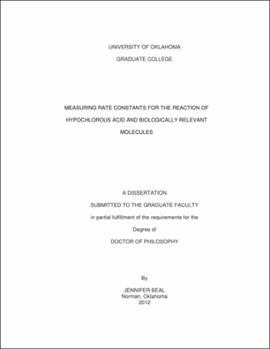| dc.contributor.advisor | Ashby, Michael T | |
| dc.creator | Beal, Jennifer | |
| dc.date.accessioned | 2019-05-01T17:25:02Z | |
| dc.date.available | 2019-05-01T17:25:02Z | |
| dc.date.issued | 2012 | |
| dc.identifier | 99138105802042 | |
| dc.identifier.uri | https://hdl.handle.net/11244/319494 | |
| dc.description.abstract | Hypochlorous acid (HOCl) is a neutrophil-derived oxidant that is used to kill invading pathogens. Since HOCl reacts indiscriminately with biological molecules, such as amino acids, excess or misplaced production of HOCl can cause host tissue damage. Methionine (Met), one of only two naturally occurring sulfur amino acids, reacts fast with HOCl making it one of the first targets. The mechanism for this reaction is not well known but is assumed to go through a chlorosulfonium intermediate to form methionine sulfoxide (MetO), and then methionine sulfone (MetO2). | |
| dc.description.abstract | The first chapter of this dissertation introduces topics which will help the reader understand the significance of the research that is described herein. The second chapter presents the new method, which we called inhibitory titrations (IT). IT is an expansion of the competition method that is commonly used for measuring rate constants of fast reactions. IT tries to minimize assumptions that can create problems when indirectly measuring rate constants by: 1) making use of all the data collected (the rate constant measured using just the 50% inhibition point can underestimate the rate constant compared to that which fits all of the data); and 2) consideration of the stoichiometry of the reaction, which was important for accurately fitting data, especially when over-oxidation is possible. Our data shows that taking the stoichiometry of the reaction into consideration produces a better fit of the experimental data than assuming the reaction has a 1:1 stoichiometry. Without consideration of the rate law for the reaction, one may derive a first order rate constant from a second order reaction, leading to a misrepresentative rate constant. | |
| dc.description.abstract | The third chapter examines thioether reactions with HOCl with the expectation that a chlorosulfonium intermediate could be characterized. In general, HOCl reacts with thioethers, at neutral pH, with a second order rate constant of 106-108 M-1s-1, consistent with those reported in literature. The reactions studied did not show definitive evidence for the formation of a chlorosulfonium ion intermediate. However, the observed product, dehydromethionine (DHM), formed in the reaction of Met with HOCl (studied in greater detail in the fourth chapter), gives insight into the identity of the intermediate. Due to the hypothesized method by which DHM is formed, from intramolecular attack followed by ring closure, a halosulfonium intermediate can account for the formation of the DHM product. | |
| dc.description.abstract | The fourth chapter describes an investigation of the reaction of free Met, peptide bound Met, and protein bound Met, by various two electron oxidants. Oxidation of Met, which has a free amine, can form either MetO or DHM, a potential biomarker of oxidative stress. Different oxidants form different percentages of DHM. Two electron oxidants that react through oxygen transfer do not produce DHM, while halogenating species (but not the pseudohypohalous acid HOSCN) that react through a halide cation (X+, where X = I, Br, or Cl) transfer, produce a significant amount of DHM. The halogenating agents can be grouped by the yields of DHM they produce, where chlorinating agents produce around 43% DHM, brominating agents approximately 75%, and iodinating agents close to 100% DHM. The percentage of DHM formed is related to the type of halosulfonium that is formed, whether it is a chlorosulfonium, bromosulfonium, or iodosulfonium species. Comparing analogous halosulfonium species, the stability towards hydrolysis is I > Br > Cl, reflecting the trend observed in the yields of DHM. The ease of formation along with the high kinetic stability of DHM at neutral pH, which in the absence of catalysts has a half life of over 600 days, shows the high potential for DHM as a biomarker of protein oxidation by halogenating agents. | |
| dc.description.abstract | The fifth chapter is a summary of important findings of this research along with recommended future experiments. Overall, the dissertation examines fast (k = 106-108 M-1s-1) reactions of HOCl and related oxidants with biologically relevant molecules. | |
| dc.format.extent | 214 pages | |
| dc.format.medium | application.pdf | |
| dc.language | en_US | |
| dc.relation.requires | Adobe Acrobat Reader | |
| dc.subject | Neutrophils | |
| dc.subject | Methionine | |
| dc.subject | Oxidation | |
| dc.title | MEASURING RATE CONSTANTS FOR THE REACTION OF HYPOCHLOROUS ACID AND BIOLOGICALLY RELEVANT MOLECULES | |
| dc.type | text | |
| dc.type | document | |
| dc.thesis.degree | Ph.D. | |
| ou.group | College of Arts and Sciences::Department of Chemistry and Biochemistry | |
